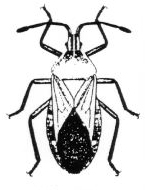 What is a True Bug? - August 9, 2006 Jeff Schalau, County Director, Associate Agent, Agriculture & Natural Resources Arizona Cooperative Extension, Yavapai County Many gardeners are curious and interested in bugs. We usually categorize them as good ones or bad ones depending on what we experience and learn by reading and observing. For most, the term “bug” is a casual designation we use to describe a variety of insects including some arthropods. Most of us know the difference between insects and spiders, but people often bring me “bugs” that have more than 6 legs. To an entomologist, a bug is an insect in the order Hemiptera which includes aphids, leafhoppers, cicadas and “true bugs”. True bugs have very distinctive front wings, called hemelytra, in which the basal half is leathery and the apical half is membranous. At rest, these wings cross over one another to lie flat along the insect's back. Where the wings cross on their back, there is often a visible triangle-shaped design which can distinguish true bugs from other insects. True bugs do not have a larval stage and the nymphs (juveniles) often bear little resemblance to the adults. True bugs also have piercing-sucking mouthparts which form a flexible feeding tube (proboscis) that is no more than 0.1 mm in diameter yet contains both a food channel and a salivary channel. They use this unique apparatus to feed on plants, other insects, and animals (including humans). True bugs include a diverse assemblage of insects that have become adapted to a broad range of habitats -- terrestrial, aquatic and semi-aquatic. The aquatic and semi-aquatic true bugs include backswimmers, water striders, and giant water bugs (for which Big Bug Creek is named). All of these are predators of other insects and small vertebrates, or scavengers. Backswimmers and giant water bugs can inflict a painful bite. People may be aware of terrestrial true bugs for a variety of reasons. Squash bugs are pests of squash and pumpkins. They feed on the stems and leaves and inject a substance which causes the plant to wilt. Squash bugs are often found in large populations, congregated in dense clusters on vines and unripe fruits. Plant bugs, seed bugs, and stink bugs are common in landscapes where they feed on foliage, fruit, and seeds. Their damage can be significant on young plants. Many of these species exude unusual odors. In my yard, stink bugs congregate at the bases of ash trees in the spring. When my weed eater hits them, it smells very distinctive (not necessarily foul, but like a chemical). There are several hundred species of these bugs in North America. Box elder bugs fall into this category. The leaf-footed plant bug is an interesting species found in the Verde Valley. It has leaf-like appendages on its back legs. Some true bugs are predatory and are considered beneficial in the garden and landscape. Some of these are the minute pirate bug, assassin bug, and ambush bug. Minute pirate bugs feed and small insects and eggs of other insects like the corn earworm. Ambush bugs catch prey by sitting still on flowers. They capture prey with their mantis-like front legs. Assassin bugs killer their prey by injecting it with a toxin that dissolves the victim’s tissue. It then sucks up the liquefied tissue with its long proboscis. Conenose bugs are related to assassin bugs, but feed on blood of small mammals and occasionally humans. Conenose bugs, also known as Hualapai tigers and kissing bugs, are common in Arizona. They usually live in packrat dens, but are attracted to lights and can enter homes through small openings. Some people have an allergic reaction to their bite. Bed bugs are also true bugs. These are small, wingless insects that also feed on blood. In fact, they require a blood meal to complete their life cycle and become sexually mature. Close relatives of bed bugs include the bat bug which is common in attics infested with bats, and swallow and chimney swift bugs which are frequent in homes inhabited by swallows, pigeons, and other wild birds. These insects prefer hosts other than humans; however, they may feed on humans if other hosts are not available. The University of Arizona Cooperative Extension has publications and information on gardening and pest control. If you have other gardening questions, call the Master Gardener line in the Cottonwood office at 646-9113 ext. 14 or E-mail us at cottonwoodmg@yahoo.com and be sure to include your address and phone number. Find past Backyard Gardener columns or submit column ideas at the Backyard Gardener web site: http://cals.arizona.edu/yavapai/anr/hort/byg/. |